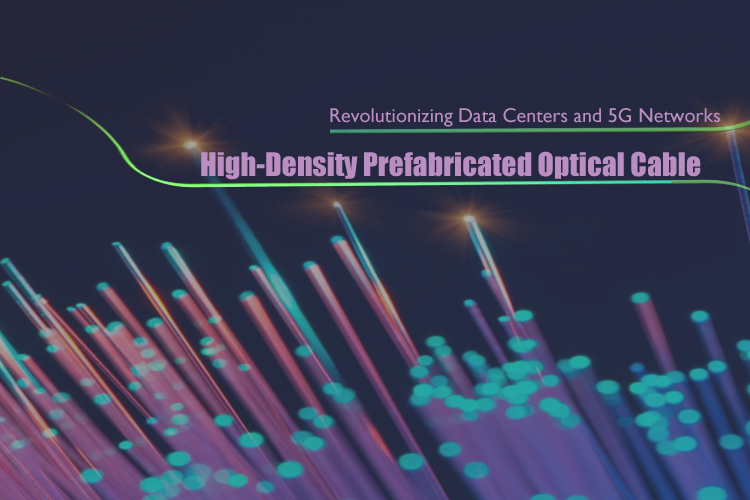High-Density Prefabricated Optical Cable: Revolutionizing Data Centers and 5G Networks
In the era of data-driven technologies and the rapid evolution of 5G networks, the demand for ultra-high-density optical fibers has become crucial. To meet this ever-growing need, the advent of high-density prefabricated optical cables has emerged as a game-changer. These innovative cables are designed to increase the number of optical fiber cores and fibers per unit area, providing a solution that transforms the landscape of data centers and 5G network infrastructure.

The Need for Ultra-High-Density Optical Fibers
As data centers and 5G networks continue to expand, the demand for higher bandwidth and faster data transmission speeds has skyrocketed. Traditional optical cables, while effective, have limitations in terms of the number of fibers they can accommodate within a given space. This limitation hampers the scalability and efficiency of these critical infrastructures.
Introducing High-Density Prefabricated Optical Cables
High-density prefabricated optical cables offer a revolutionary solution to the challenges faced by data centers and 5G networks. These cables are designed with advanced technologies and innovative manufacturing techniques that allow for a significantly higher number of optical fiber cores and fibers per unit area compared to traditional cables.
Benefits and Advantages
1. Unprecedented Scalability
With their enhanced fiber density, high-density prefabricated optical cables enable data centers and 5G networks to accommodate a much larger number of fibers within the same physical space. This scalability allows for future expansion without the need for extensive infrastructure modifications, reducing costs and minimizing disruptions.
2. Increased Bandwidth
By accommodating more fibers, high-density prefabricated optical cables provide a significant boost in available bandwidth. This increased bandwidth enables faster data transmission speeds, supporting the ever-growing demands of data centers and 5G networks.
3. Enhanced Flexibility and Versatility
High-density prefabricated optical cables come in various designs and configurations to suit different installation requirements. From microduct cables to ribbon cables, these cables offer versatility in deployment, making them highly adaptable to different network architectures and environments.
4. Streamlined Installation and Maintenance
The prefabricated nature of these optical cables simplifies the installation and maintenance processes. The cables are factory-terminated and tested, minimizing the need for on-site splicing and reducing the risk of errors. This streamlined approach saves time, effort, and costs associated with deployment and maintenance.
Applications in Data Centers
Data centers are at the forefront of the digital revolution, serving as the backbone for numerous online services and applications. High-density prefabricated optical cables are playing a pivotal role in optimizing data center infrastructure by providing ultra-high-density connectivity solutions.
From interconnectivity within server racks to high-speed connections between data center zones, these cables enable data centers to handle massive volumes of data traffic with improved efficiency and reliability. The increased fiber density empowers data centers to support emerging technologies such as cloud computing, artificial intelligence, and edge computing.
Empowering 5G Networks
The deployment of 5G networks is transforming the way we connect and communicate. High-density prefabricated optical cables are instrumental in realizing the full potential of 5G by delivering the necessary infrastructure to support the unprecedented demand for high-speed, low-latency connectivity.
From fronthaul to backhaul connections, these cables enable seamless transmission of data between 5G base stations and core networks. The enhanced fiber density ensures that the network can handle the vast amount of data generated by an increasingly connected world, enabling faster downloads, real-time communication, and the Internet of Things (IoT) applications.
Conclusion
The emergence of high-density prefabricated optical cables has revolutionized data centers and 5G networks, providing a scalable, high-bandwidth, and versatile solution to meet the demands of the digital age. By increasing the number of optical fiber cores and fibers per unit area, these cables empower data centers and 5G networks to handle the ever-growing volume of data traffic with efficiency and reliability.
As technology continues to evolve, high-density prefabricated optical cables will play a crucial role in shaping the future of data transmission and connectivity. With their unique capabilities and advantages, these cables are paving the way for a more connected and data-driven world.
FAQs
1. How does high-density prefabricated optical cable differ from traditional optical cables?
High-density prefabricated optical cables can accommodate a significantly higher number of fiber cores and fibers per unit area compared to traditional cables. This enables greater scalability, increased bandwidth, and enhanced flexibility.
2. Are high-density prefabricated optical cables compatible with existing infrastructure?
Yes, high-density prefabricated optical cables can be seamlessly integrated into existing infrastructure. They are designed to be versatile and adaptable, allowing for easy deployment and compatibility with different network architectures.
3. What are the advantages of using high-density prefabricated optical cables in data centers?
High-density prefabricated optical cables offer benefits such as unprecedented scalability, increased bandwidth, enhanced flexibility, and streamlined installation and maintenance processes. These advantages optimize data center infrastructure and support emerging technologies.
4. How do high-density prefabricated optical cables contribute to 5G networks?
High-density prefabricated optical cables empower 5G networks by providing the necessary infrastructure to support high-speed, low-latency connectivity. They enable seamless transmission of data between 5G base stations and core networks, facilitating faster downloads, real-time communication, and IoT applications.
5. What is the future outlook for high-density prefabricated optical cables?
As technology continues to advance and data demands increase, high-density prefabricated optical cables will play a crucial role in meeting the evolving needs of data centers and 5G networks. Their scalability, bandwidth capabilities, and versatility make them an essential component of future connectivity solutions.

 The Future of Fiber Optic Communication Network Architecture: Evolution and the Role of SDON Technology
The Future of Fiber Optic Communication Network Architecture: Evolution and the Role of SDON Technology
 What opportunities and challenges does free-space optical communication technology face?
What opportunities and challenges does free-space optical communication technology face?
 Opelink MPO Products for High-Speed Data Center Applications
Opelink MPO Products for High-Speed Data Center Applications
 CWDM vs. DWDM: Which Optical Transmission Technology Should You Choose?
CWDM vs. DWDM: Which Optical Transmission Technology Should You Choose?